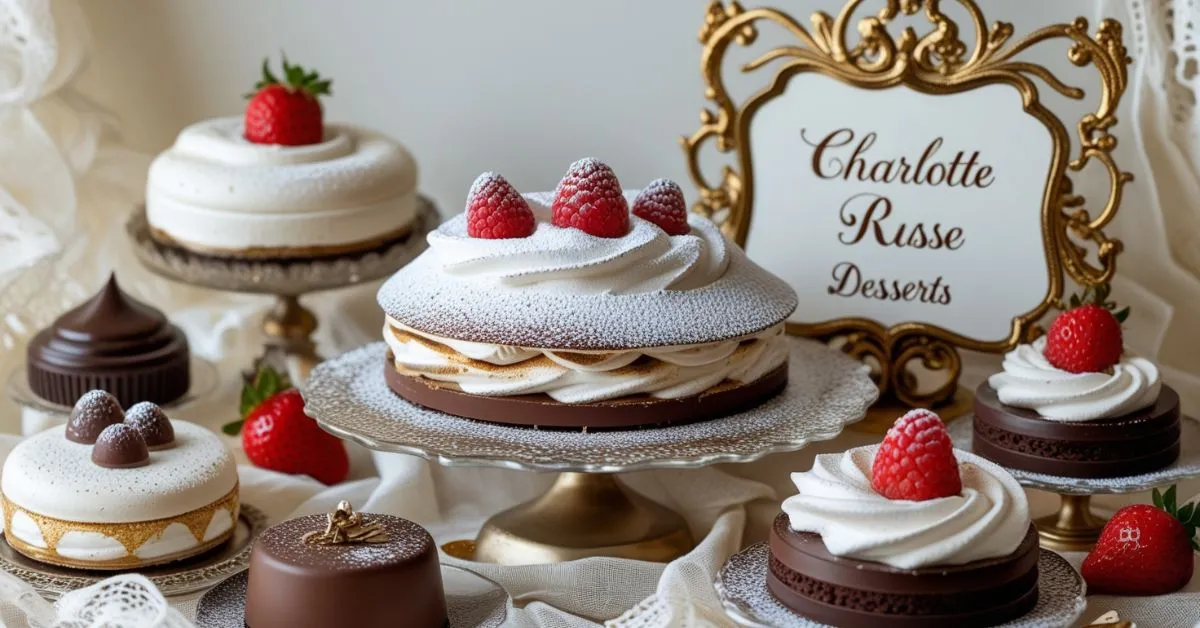Charlotte Russe desserts have been a staple in classic baking for generations, offering a unique combination of texture and flavor. This dessert, once a favorite in European and American households, has an intriguing history and a versatile recipe that can be adapted for various occasions. Whether you’re a home baker or someone exploring culinary traditions, understanding the origins and making of Charlotte Russe desserts can add a fascinating dimension to your cooking repertoire.
The Problem: Lost Culinary Traditions and Forgotten Recipes
In today’s fast-paced world, many traditional desserts have faded into the background, replaced by modern, mass-produced sweets. People are often unaware of historically significant recipes, missing out on the depth of flavors and experiences that come with them. Charlotte Russe desserts fall into this category—once a widely celebrated treat, it has become lesser-known in contemporary kitchens.
Agitate: Why We Should Revive Charlotte Russe Desserts
The decline of Charlotte Russe desserts is unfortunate because they offer a balance of richness and simplicity. The dessert consists of a sponge cake or ladyfingers lined in a mold and filled with Bavarian cream, custard, or fruit-based mixtures.
It’s a no-bake dessert (in some versions), making it accessible to those who want an elegant treat without complicated techniques. The origins of Charlotte Russe desserts date back to the early 19th century, attributed to French chef Marie-Antoine Carême.
Named in honor of Queen Charlotte, wife of King George III, and incorporating “Russe” to acknowledge Russian influences, this dessert became popular in European aristocratic circles before spreading to America.
Yet, despite its historic importance, Charlotte Russe desserts are rarely seen in modern bakeries or homes. The shift toward commercialized desserts has overshadowed this dish, and many younger generations may never have had the chance to experience it.

Solution: Rediscover and Make Charlotte Russe Desserts at Home
The best way to bring back Charlotte Russe desserts is by understanding how simple and adaptable they are to make at home. Here’s how you can create an authentic version of this dessert:
Ingredients:
- 24 ladyfingers or sponge cake slices
- 2 cups heavy cream
- 1/4 cup sugar
- 1 teaspoon vanilla extract
- 1 tablespoon gelatin (dissolved in 2 tablespoons water)
- 1/4 cup milk
- Fresh fruit or fruit preserves (optional)
- Whipped cream and chocolate shavings for garnish
Instructions:
- Line a mold or individual dessert cups with ladyfingers or sponge cake slices.
- In a mixing bowl, whip the heavy cream, sugar, and vanilla extract until soft peaks form.
- Dissolve the gelatin in warm milk and gently fold it into the whipped cream mixture.
- Pour the filling into the prepared mold and smooth the top.
- Refrigerate for at least 4 hours or until set.
- Garnish with whipped cream and fruit before serving.
This traditional preparation method allows for slight variations. You can substitute the cream filling with fruit-flavored Bavarian cream, chocolate mousse, or even a lighter yogurt-based mixture for a modern touch.
Why Charlotte Russe Desserts Deserve a Comeback
Charlotte Russe desserts are more than just a sweet treat—they represent a link to culinary history and a testament to the evolution of desserts. Their elegant presentation and ease of preparation make them an ideal choice for home bakers looking to impress guests without spending hours in the kitchen.
Additionally, with the resurgence of interest in vintage recipes, Charlotte Russe desserts fit well into the movement of rediscovering and preserving traditional dishes. Social media platforms have played a role in bringing back old-fashioned desserts, and Charlotte Russe could be the next big revival.
By incorporating this dessert into your baking routine, you not only enjoy a delicious, creamy treat but also contribute to keeping a historic dish alive. Whether you follow a classic recipe or create your own variations, Charlotte Russe desserts deserve a place on your table.
Final Thoughts
Charlotte Russe desserts are an easy yet sophisticated dessert option that should not be forgotten. By understanding their history, appreciating their simplicity, and trying out the recipe yourself, you can help bring back this timeless treat. Whether served at a special gathering or enjoyed as a personal indulgence, Charlotte Russe is a dessert that stands the test of time.
FAQs
What is a Charlotte Russe dessert?
Charlotte Russe is a classic dessert made with a mold lined with ladyfingers or sponge cake and filled with Bavarian cream or mousse. It was created by French chef Marie-Antoine Carême in the 19th century. The dessert is often topped with fruit or whipped cream for added flavor.
What is Charlotte Russe made of?
Charlotte Russe is made of a sponge cake or ladyfinger lining filled with Bavarian cream, mousse, or custard. The filling is typically flavored with vanilla, chocolate, or fruit purée. It is often topped with whipped cream and fresh fruit for decoration.
What dessert is charlotte known for?
Charlotte is known for the Charlotte Russe, a dessert made with ladyfingers or sponge cake filled with Bavarian cream or mousse. Another variation is Charlotte Royale, which features a jelly roll exterior with a creamy filling. Both are elegant, classic French desserts often served chilled.
What is Charlotte cake made of?
Charlotte cake is made of ladyfingers or sponge cake arranged in a mold and filled with mousse, custard, or Bavarian cream. The filling can be flavored with vanilla, chocolate, or fruit purée. It is often chilled and topped with whipped cream or fresh fruit.
